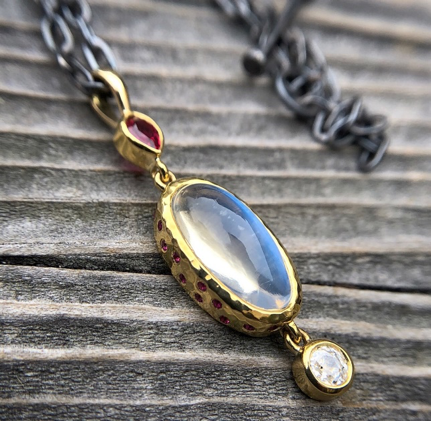@thesisgems for our next show date

Five Gems that Capture My Imagination
Posted on
The most coveted gems change over time and across cultures. Cleopatra revered emeralds, royals have collected rubies for centuries, and the Hollywood red carpet is a wave of diamonds.
Every gemstone has a long and unique history of usage and significance. These layers of meaning make jewelry endlessly fascinating for the collector. They also make it hard to choose favorites.
What is Your Favorite Gem?
Nearly all gems have the power to capture my imagination. Pearls, sapphires, spinel and others can connect me to significant memories, while reminding me to enjoy the present.
There are some qualities, however, that many of my favorite gemstones share in common.
I am most drawn to vibrant gems with unusual properties, like reflective surfaces or changing colors. These effects never cease to intrigue and delight me, not only for their aesthetic beauty, but also the science behind them.
A sapphire shines even brighter when you learn about the minerals it’s comprised of, the river it was formed in, and the thermal treatment used to enhance its color and clarity.
Five Fascinating Gems
Recently, five gems in particular have captivated and inspired me. Their unique qualities make them a prized addition to any jewelry lover’s collection.

(Source)
1. “Rainbow” Garnet
Garnets come in many varieties, displaying shades of green, red, yellow, and orange. Tsavorite garnet, for example, offers a rich green that I find spellbinding.
A newly found favorite variety is the iridescent or “rainbow” garnet. This is an especially rare gem named for its colorful, luminous properties.
“Rainbow” garnet is a unique combination of grossular and andradite garnet. It is found in deep brown, gray, green, and yellow hues, with a prismatic play of color under the light. I recently purchased a small parcel of this rare gem that was mined in Mexico.

Compass pendant with Australian boulder opal

Hopkins Australian Lightening Ridge Solid Black Opal
2. Opal
Opals are formed by water running down through the earth. Water picks up silica from sandstone as it travels, leaving behind silica deposits when it evaporates. It takes 5 to 6 million years for this natural process to form a one centimeter opal.
Opals display a unique array of colors that flirt with your gaze — a property called opalescence. The silica deposits that make up a single opal act like many tiny prisms refracting the light.
These glowing gems have long been associated with luck, hope, innocence, and happiness.

Amici pendant with mabe pearl and opal

Sea of Cortez Pearls
3. Pearl
Like opals and “rainbow” garnet, pearls also have an iridescence that makes them glow. Unlike most other gemstones, pearls are organic and need no cutting, polishing, or enhancement to bring out their beauty.
Pearls naturally occur in a variety of colors and shapes. My favorite varieties are Japanese kasumi pearls, found in shades of orange, peach, and pink, and Sea of Cortez pearls, which come in opalescent gray, gold, blue, and more.

Source: Barbara Lawrence Moonstone at Thesis Gems and Jewelry

Source: Fine Moonstone, Ruby and Diamond Pendant by Thesis Gems and Jewelry, available at Zaver and Mor
4. Moonstone
Ancient Roman and Hindu mythology say moonstone is made of frozen moonbeams. To this day it evokes magic and is closely associated with healing, protection, and intuition.
Moonstone’s soft glow and rays of silvery blue light are reminiscent of moonlight on the water’s surface. This effect is called adularescence, a phenomenon caused by light hitting thin layers of minerals within the gem.
Moonstone is found in white, gray, green, peach, and brown. It is typically carved to a smooth dome to show off its ethereal shine; tilt it in your hand and watch light move across the surface.

(Source)
5. Alexandrite
If you look at an alexandrite indoors, then take it into the sunshine, you’ll see it
change color almost miraculously. That’s why people say alexandrite is an “emerald by day, ruby by night.”
The color-shifting “alexandrite effect” is a result of the gem’s unique light-absorbing properties. Due to its crystal structure, alexandrite only absorbs light from a narrow range of wavelengths in the visible light spectrum.
Named for Tsar Alexander II, who freed Russia’s serfs in the 19th century, this daring gem is exceptionally rare and delightful to wear.
Discover Your Passion for Gemstones
I never cease learning about the places, faces, and stories behind my favorite gems. And there are always new favorite gems to discover.
If gemstones and jewelry have captured your imagination, welcome to a lifelong love affair. I would love to help you select or design a piece of wearable art that displays your favorite gem — and reflects your unique personality. Contact me today for a phone consultation.Subscribe to our newsletter
News, Recent Collabs and Events. Directly to your inbox.
Contact
(510) 556-6443

